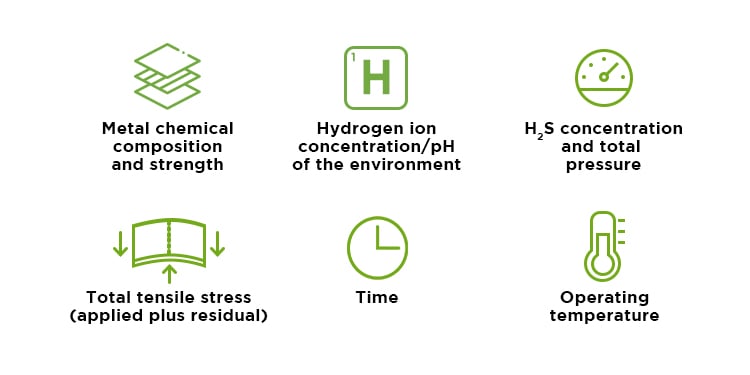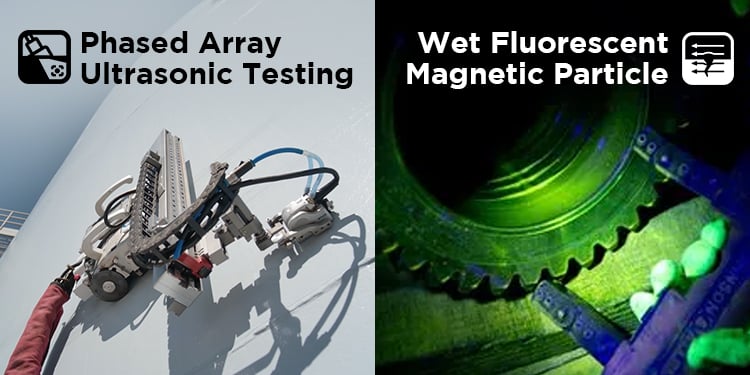Sour service, or wet hydrogen sulfide (H2S), environments are commonly seen in the oil refining, petrochemical, chemical, and gas industries as a result of hydrocarbon production. Hydrogen induced cracking (HIC), stress oriented HIC (SOHIC), and sulfide stress cracking (SSC) are wet H2S damage mechanisms that cause corrosion, cracking, and blistering in the base metal of assets. This article will discuss how SSC occurs and how to detect it.
SSC was first identified in wellhead and pipeline valves in the 1940s, in the wake of some steel equipment failures in oil and gas systems in North America. Over time, the occurrence of SSC became more widely recognized and identified in additional oilfield and refinery assets.
In 2003 major requirements for refineries and upstream production were recognized with the release of NACE MR-0103,1 “Petroleum, petrochemical and natural gas industries — Metallic materials resistant to sulfide stress cracking in corrosive petroleum refining environments.” This document provides guidelines for the material composition of equipment operating in sour service environments.
Generally, according to the leading industry journal Inspectioneering, SSC affects metals such as carbon and low-alloy steels, as well as titanium, nickel, and aluminum alloys—particularly zones of high hardness and areas where steels and weldments contain high amounts of residual hardening elements. When possible, most SSC problems can be prevented with the selection of resistant materials. But, even with intentional material selection and equipment design, it does not guarantee SSC resistance because tensile stresses, operating conditions, and other factors all play a significant role in SSC.
So, what exactly causes SSC, and how does it happen?
Sulfide Stress Cracking: Where and How?
SSC is under the umbrella of embrittlement; the process of a material becoming fragile or more easily broken due to loss of ductility (an object’s ability to have its shape altered without breaking or losing strength). In other words, how malleable material is or the stress it can withstand before fracturing. If unchecked, embrittlement can lead to SSC or other types of brittle failure, even at stresses below the typical yield point of susceptible materials. This means that traditional safety factors for design are not valid to prevent failure.2
In corrosive sour service environments typical to oil and gas production, SSC occurs where susceptible materials react with hydrogen sulfide, the byproducts of which are metal sulfides and atomic hydrogen. These elements combine and diffuse into the metal matrix at sites of high internal stress—discontinuities including grain boundaries, inclusions, or welds, for example—and when exposed to tensile stresses, embrittlement and subsequent cracking can occur. Metal alloys (iron alloys and high-strength steels) that are normally ductile most often experience SSC under tensile stress and high temperatures. The worst cases of SSC usually occur at lower temperatures close to the wellhead (e.g., between room temperature and 140°F/60°C).3
 According to NACE, SSC can be influenced by many factors, including the following:
According to NACE, SSC can be influenced by many factors, including the following:
- Metal chemical composition, strength, heat treatment, and microstructure
- Hydrogen ion concentration/pH of the environment
- H2S concentration and total pressure
- Total tensile stress (applied plus residual)
- Operating temperature
- Time
What makes SSC particularly sinister is that while an asset or component may look normal from the outside—operating in conditions below the typical yield stress of the material—it could still be experiencing any stage of SSC beneath the exterior. SSC can happen without any indication and very quickly progress. Onset can occur in just hours, but it could also take years to cause catastrophic failure.
Beyond material selection, the other key to avoiding SSC damage and all the potential negative consequences is to understand how to detect and manage the condition by scheduling routine professional inspections.
Detection and Inspection
The two main types of inspection techniques used for SSC detection are Wet Fluorescent Magnetic Particle (WFMP) Inspection and Phased Array Ultrasonic Testing (PAUT). In short, WFMP requires magnetization of a component and subsequent coating in magnetic particles. Particles are attracted to the defects which become visible under UV light. While fairly simple and cost-effective, the asset does have to be ferromagnetic and demagnetized afterward. Additionally, it can only detect surface and near-surface cracks, when the threat of SSC can occur sub-surface without warning.

Phased Array Ultrasonic Testing, an advanced nondestructive testing technique, is excellent for SSC detection and weld inspections of pressure vessels, pipes, tubes, and other types of damage, including HIC and SOHIC. While offering many advantages including accuracy, speed, repeatability, safety, and more, it often requires a higher initial investment. However, due to how quick and accurate the technology is when performed by experienced professionals, it is common for the cost to balance out.
In summary, even when following recommended/professional guidelines for sour service material selection, SSC can still occur and is largely influenced by a slate of operating factors. Understanding potential susceptibility and taking proactive, preemptive measures such as regularly scheduled, professional asset inspections will help ensure its health and safety. This includes the prevention of insidious SSC scenarios, but also many other potential conditions that, if gone undetected for too long, are inconvenient and expensive at best.
References:
- King, Roger A. Trends in Oil and Gas Corrosion Research and Technologies, 2017, pages 271-294.
- Skogsberg, James. “Overview of Corrosion in the Oil and Gas Industry.” Rice University Corrosion Seminar, 2017.
- Iannuzzi, M. Environmentally assisted cracking in oil and gas production, Stress Corrosion Cracking, 2011.
